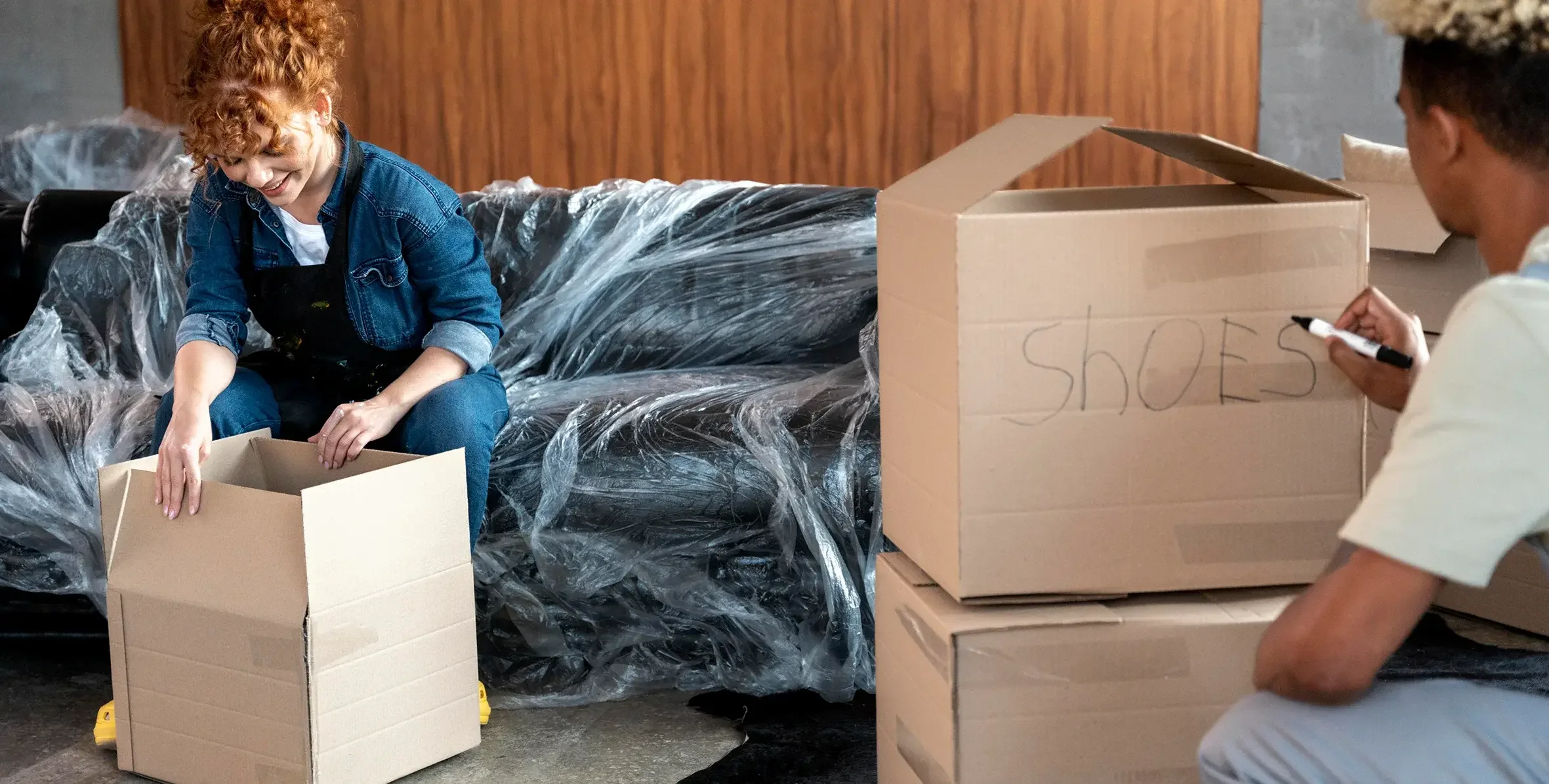
- Home
- -
- How to Pack for a Long-Distance Move
How to Pack for a Long-Distance Move
Success is where preparation and opportunity meet.
If you’re standing in your living room surrounded by half-packed boxes, wondering how you’re going to move your entire life hundreds or even thousands of miles away, you’re definitely not alone.
According to U.S. Census data, every year, millions of Americans relocate across the country, and about 9% of those moves are long-distance. Whether you’re moving for a new job, to be closer to family, or just chasing a change of scenery, packing for a long-distance move can feel like a mountain to climb.
That’s exactly why we’ve put together this complete guide to help you avoid the chaos and feel confident about your move. We’ll discuss expert tips and the best strategies that actually work when you’re getting ready for a big relocation.
If you’ve been Googling things like how to pack for a move across the country, then you’ve landed in the right place.
How to Pack for a Long-Distance Move
Whether you’re heading two states away or from New York to California, this isn’t the kind of move you can delay till the last minute. Packing for a cross-country move takes planning, patience, and the right techniques.
So here’s how to perform it step-by-step.
Start With a Packing Plan
First, don’t just start throwing stuff in boxes. You need a plan. Begin by deciding when to start packing. Most moving experts recommend starting about 6 to 8 weeks before your move date. That gives you plenty of time to stay organized and avoid the last-minute scramble.
This is also the time to decide if you’re going full DIY or hiring professionals. Some people prefer doing it all themselves, while others bring in help for the heavy lifting or even for full-service packing.
Declutter Before You Pack
Go room by room and figure out what’s worth taking with you. Remember, the more you move, the more it costs. Reducing your load not only saves money but also makes unpacking on the other end so much easier.
As a general rule, if you haven’t used it in the past year, you probably don’t need it. Donate it, sell it, or discard it.
This is a key part of how to organize a long-distance move, because there’s no point in carefully packing items you no longer want or need.
Get the Right Supplies
You’d be surprised how many people underestimate the number of boxes and materials they’ll need. Stock up on high-quality supplies early. At a minimum, you’ll need:
- Sturdy moving boxes in various sizes
- Heavy-duty packing tape
- Bubble wrap and/or packing paper
- Markers and labels for labeling boxes
- Ziplock bags for screws, bolts, or tiny parts
- Stretch wrap for furniture
These are your essential long-distance moving supplies, and skimping here is one of the biggest mistakes people make. A weak box or cheap tape can damage your items and make unpacking stressful.
Pack Room by Room to Stay Organized
When it’s time to actually pack, go room by room. This makes it easier to track what’s been packed and simplifies unpacking later. Start with non-essentials like guest rooms, storage closets, or seasonal decor, and work your way toward the rooms you use every day.
Clearly label each box with the room it belongs to and a quick summary of what’s inside. For example: “Kitchen – Pots & Pans” or “Bedroom – Nightstand Items.” Some people even number their boxes and keep an inventory sheet with the contents of each box.
This method is one of the best ways to pack for a long-distance move, because it keeps you focused and reduces the overwhelm.
Pack Heavy Items in Small Boxes, Light Items in Big Boxes
 This is a pro tip that makes a huge difference: keep heavy stuff, like books or tools, in smaller boxes. That way, they’re easier to lift and less likely to fall apart. Save your big boxes for lighter items like linens, pillows, or plastic kitchenware.
This is a pro tip that makes a huge difference: keep heavy stuff, like books or tools, in smaller boxes. That way, they’re easier to lift and less likely to fall apart. Save your big boxes for lighter items like linens, pillows, or plastic kitchenware.
If you’re packing for a move in a truck, you’ll want to distribute weight evenly to keep the load stable during transit.
Wrap and Cushion Everything
When you’re moving across the country, your stuff will hit bumps, turns, and long stretches of road. That’s why wrapping and cushioning are so important. For breakables like dishes, glasses, or picture frames, wrap each item individually with packing paper or bubble wrap.
When it comes to packing fragile items for a move, always double-pad glass or ceramic items and fill empty space in the box with crumpled paper or towels to avoid movement. And don’t forget to write “Fragile” and “This Side Up” on the outside of the box!
Don’t Forget to Label Every Box
Label everything. Use a thick marker to clearly note the room, contents, and if it’s fragile. You can also color-code boxes with stickers or colored tape by room (e.g., red = kitchen, blue = bedroom). This helps both you and your movers place boxes in the right room at the new house without opening every single one.
Create an Essentials Box (Or Two)
Pack a few boxes with things you’ll need right away when you arrive, like a change of clothes, toiletries, medications, phone chargers, basic kitchen supplies, snacks, and maybe even coffee.
Also, keep important documents like passports, insurance papers, birth certificates, and financial records with you, not in the moving truck.
Packing Mistakes to Avoid
 Even with the best intentions, it’s easy to slip up when you’re packing for a long-distance move. Let’s go over some common mistakes people make.
Even with the best intentions, it’s easy to slip up when you’re packing for a long-distance move. Let’s go over some common mistakes people make.
Starting Too Late
Procrastination is your worst enemy here. Start packing at least 6 weeks before your move to avoid the last-minute panic. A rushed job usually means broken items and poor organization.
Skipping a Packing Plan
If you are randomly throwing things into boxes, you’re essentially planning for a disaster. Pack one room at a time and keep track of what’s in each box. That’s how you stay on top of how to organize a long-distance move.
Using Weak or Overused Boxes
Cheap, flimsy boxes fall apart fast, especially in a moving truck. Invest in strong, quality materials. It’s one of the most important long-distance moving supplies you can buy.
Overloading Boxes
Heavy items belong in small boxes. Light stuff goes in big ones. This keeps your back safe and your boxes intact during the journey. It’s a classic rule in packing tips for moving long distances.
Poorly Packing Fragile Items
Don’t cut corners with glassware, electronics, or anything delicate. Wrap, pad, and clearly label these boxes. Knowing how to pack fragile items for a move can save you hundreds in replacements.
Forgetting the Essentials
Always pack a separate box with everyday items: clothes, toiletries, chargers, and snacks. This small move will save you big frustration on day one.
After the Move – Unpacking Tips
After all that packing for a long-distance move, your boxes are finally in your new home. Now comes the part that feels less urgent: unpacking. Do it right, and you’ll settle in faster.
Unpack Essentials First
Start with the box that has your must-haves: clothes, toiletries, meds, chargers, and anything you’ll need in the first day or two.
Go Room by Room
Unpack one room at a time, beginning with the bedroom, bathroom, and kitchen. Because you followed smart long-distance moving tips, your boxes should already be labeled by room.
Take Your Time
Don’t rush to unpack everything in one day. Focus on what you need now. Extra stuff like decor can wait. A slow, steady pace works better than chaos.
Watch for Broken Items
Open fragile boxes carefully and check for damage. If anything breaks, take photos and contact your mover immediately, especially if you followed proper steps to pack fragile items for a move.
Declutter (Again)
If you unpack something and wonder, “Why did I bring this?”—don’t keep it. Discard or donate it. Even after a detailed packing, it’s okay to change your mind.
Recommended Resources
How to Plan a Smooth Move When Moving with Pets
FAQs
You should start packing 6 to 8 weeks before your move. Begin with non-essentials and work toward daily-use items as moving day approaches. Early packing reduces stress and helps you stay organized.
Hiring professionals can save time and ensure better protection for your belongings, especially fragile or valuable items. If your budget allows, they’re a smart option for large or complicated moves.
Use furniture blankets, stretch wrap, and corner protectors to prevent damage. Disassemble large pieces when possible and secure hardware in labeled bags taped to the furniture.
Avoid packing important documents, medications, electronics, cash, jewelry, and hazardous materials (like flammable liquids or aerosols). These should travel with you, not in the moving truck.
Protect your belongings with waterproof covers, plastic bins, and towels. Use rugs or cardboard to avoid tracking snow or mud into your old or new home. Always check the forecast and have a backup plan.
Recent Post


Local vs. Long-Distance Moves

What Movers Won’t Move

How to Move in Summer, Monsoon and Winter

How to Move Plants Safely

How to Move During the Holidays

Top Moving Trends 2025

DIY vs. Professional Movers

Move-In Cleaning Tips for a Clean Start

